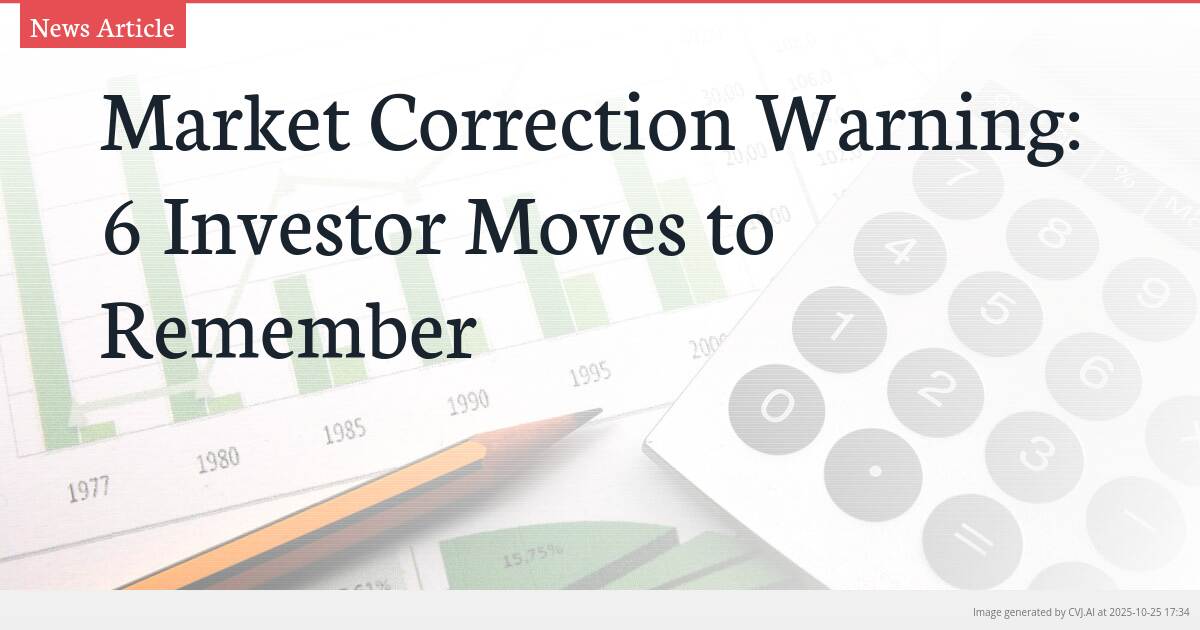This summary text is fully AI-generated and may therefore contain errors or be incomplete.
Introduction
As the S&P 500 trades at all-time highs with valuations reaching 30 times trailing earnings—significantly above historical norms—market veterans are sounding alarms about potential turbulence ahead. With the index up 35% from April lows and economic headwinds including inflation, geopolitical tensions, and a $38 trillion national debt gathering strength, experts warn that a 20% correction similar to earlier this year remains entirely possible. Investors should prepare now with defensive strategies to protect their portfolios.
Key Points
- S&P 500 trading at 30 times trailing earnings, significantly above 5-year median valuations
- Gold approaching $5000 level as safe-haven demand increases amid market uncertainty
- Treasury bonds and money markets offering 3.5-4% yields with government backing and daily liquidity
The Case for Caution in Elevated Markets
The current market environment presents a stark contrast between bullish optimism and historical precedent. The S&P 500’s stunning 35% rally from its April lows and 14% year-to-date gain has pushed the venerable index to trade at 30 times trailing earnings, much higher than the median point over the last five years. This valuation expansion occurs against a backdrop of persistent inflation concerns, ongoing conflict in Ukraine, Middle East instability, and a crushing national debt approaching $38 trillion. Market veterans who witnessed the 1987 crash—when the Dow Jones Industrial Average plunged 22% in one day—recognize that today’s equivalent drop would mean an incredible 11,000-point collapse.
While the economic system isn’t teetering on the abyss as it was during the 2008 financial crisis when Bear Stearns and Lehman Brothers collapsed—forcing Merrill Lynch into Bank of America’s arms—the current complacency among investors raises concerns. The solid economic foundation makes a full-scale market crash unlikely, but a healthy correction of 20% remains entirely possible, particularly if inflation moves higher or geopolitical tensions escalate. The path of least resistance could very well be down if these risk factors intensify.
Building Defensive Positions for Turbulent Times
Warren Buffett’s strategy of maintaining substantial cash reserves provides a template for prudent investors anticipating market volatility. Building a cash stash now creates ‘dry powder’ that can be deployed during market downturns to purchase quality assets at discounted prices. This approach aligns with matching current losses against gains to build up cash supplies, even if those gains are short-term. The wisdom of this strategy becomes apparent when considering that consumers and businesses, while in reasonably good financial shape currently, may face challenges if portfolio values decline significantly.
Margin positions represent another critical vulnerability for investors. Margin—money borrowed from brokers to purchase investments—can devastate highly leveraged accounts during market collapses. This is particularly true for high-volatility momentum stocks that tend to suffer disproportionate losses during corrections. Closing out margin positions immediately removes this leverage risk and protects investors from forced liquidations that could lock in permanent losses during market turbulence.
Safe-Haven Assets and Income Strategies
Gold and silver continue to make sense as portfolio diversifiers, with gold surging in 2025 and moving toward the $5,000 level. As 24/7 Wall St. has recommended for years, maintaining a gold position helps mitigate downside risk during market corrections. The precious metal’s return to all-time highs suggests continued safe-haven demand, and historical patterns indicate it could explode higher during a market crash, providing valuable portfolio insurance when other assets decline.
Dividend reinvestment represents another crucial strategy for weathering market volatility. Ensuring that all dividend-paying stocks and mutual funds in personal and retirement accounts are coded to reinvest all capital gains and dividends allows investors to automatically buy more shares when prices decline and fewer when investments trade higher. This disciplined approach to wealth accumulation becomes particularly valuable during the fourth quarter, when many stocks and funds pay dividends on a calendar quarterly basis.
Real estate ownership offers another avenue for portfolio protection, providing both satisfaction and lucrative returns. For investors fortunate enough to come into windfalls like inheritances, cash-generating passive income rental properties can help soften the blow of market corrections. While mortgage rates have increased over the past two years—with the 30-year fixed rate reaching as high as 7.25% before falling back to 6.12% for FHA mortgages—these levels remain reasonable on a historical basis, though they represent the highest rates since 2008.
Government-Backed Security and Yield Opportunities
U.S. Treasury bonds, certificates of deposit, and high-yield money markets currently offer attractive risk-adjusted returns for safety-conscious investors. Treasury bonds—debt securities issued and backed by the full faith and credit of the United States government—provide security amid uncertainty. The two-year Treasury note yields a solid 3.47%, while one-year certificates of deposit yield as high as 4%. Money market savings accounts, FDIC insured up to $250,000, offer yields ranging from 3.5% to 4.0% with daily liquidity.
This shift toward the short end of the Treasury market, combined with selling super high-volatility stocks, represents a prudent reallocation strategy as market risks accumulate. While Goldman Sachs has identified sectors with top 2026 payouts and JP Morgan references a ‘healthy correction’ scenario, the current environment suggests that safety precautions could be in order now. As the market enters potentially turbulent territory, these six investor moves provide a framework for navigating uncertainty while positioning for future opportunities.
📎 Read the original article on 247wallst.com

